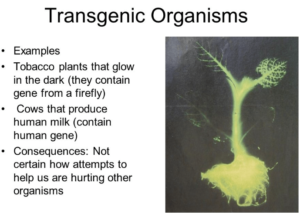Biology
Transgenic Organisms

Transgenic organisms are those that undergo some modification in their characteristics through the addition of genes corresponding to other species of organisms. The possibility that organisms are transgenic is not natural but is due to the action of man.
The existence of transgenic organisms is a contribution of genetic engineering. The objective is to increase crop productivity and contribute to sustainable agriculture that uses resources to improve food by eliminating toxic substances or modifying the proportions of its components to achieve healthier foods.
Read Also: Examples of Biotechnology
Examples transgenic Organisms
- Primates. The first genetically modified Rhesus Macaque (one of the monkey species) was born in 2000. This proved that a being as complex as this can be genetically altered.
- Tomatoes. Enzymes are inhibited to slow decomposition time.
- alfalfa. This plant is genetically modified to make it resistant to a herbicide (glyphosate).
- Coffee. Genetic modification makes it possible to increase production.
- sheep. With human genes, it would allow in the not too distant future use their organs to be transplanted into humans.
- Oranges. When exposed to ethylene, the degradation of chlorophyll is accelerated.
- Banana. To make it more resistant, two species are genetically crossed for its elaboration.
- soy. To be more resistant to herbicides, the seed is modified. A large part of the soybean is planted through direct seeding.
- Golden rice. The introduction of three new genes is carried out to obtain rice with a higher content of vitamin A.
- Salmon. A genetic cross is made between Atlantic salmon and Pacific salmon (which has a gene that stimulates growth), which gives a high economic benefit.
- cow. The genetic structure was modified so that it produces milk with an insulin precursor useful for diabetics.
- Glofish. They are fish modified with a jellyfish protein that makes them glow in white or ultraviolet light.
- RR corn. It was genetically modified to make it more resistant to glyphosate, a type of herbicide.
- potatoes. Starch enzymes are invalidated.
- Sunflower. The genes are altered to make it resistant to drought.
- Virus-resistant plum. They are plums resistant to the shark virus, a lethal virus for this species of plant.
- sugar. It is modified to make it resistant to herbicides.
- frogs. By crossing genes from two species, translucent frogs were created, which makes it possible to study the effect of chemicals on their organs.
Read Also: Transgenic foods